Quick Look
Grade Level: 5 (3-5)
Time Required: 1 hours 30 minutes
(90 minutes (three 30-minute sessions), plus optional 30 minutes for class demonstration, plus at least 5 days for crystals to grow)
Expendable Cost/Group: US $5.00
Group Size: 1
Activity Dependency: None
Subject Areas: Physical Science, Physics, Problem Solving, Reasoning and Proof, Science and Technology
NGSS Performance Expectations:

| 5-PS1-1 |
| 5-PS1-3 |
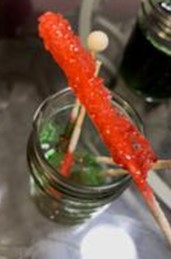
Summary
Students explore the states of matter through engaging activities, culminating in making rock candy. The lesson starts with a sticky note exercise in which students visualize how molecules behave in solids, liquids, and gases, followed by a discussion on particle arrangement and energy levels. Next, in the "Crazy Particles Game," students act out molecular behavior, mimicking how particles move in different states of matter. A rock candy demonstration (or at-home experiment) provides a hands-on example of crystallization and phase changes. Students also use computer simulations to manipulate temperature and observe particle behavior, gaining practical insights into solubility, crystallization, and the transitions between solids, liquids, and gases.Engineering Connection
Chemical engineers use science to solve problems and create useful things. They know a lot about chemicals and how different materials behave. For example, they figure out how to make food such as candy and chocolate, create fuels for cars and planes, and even help clean dirty water. They design special processes to turn raw materials into products we use every day, making sure everything is safe and works well. Think of them as problem-solvers who mix science and creativity to make the world a better place!
Learning Objectives
After this activity, students should be able to:
- Classify matter as solid, liquid, or gas based on particle movement.
- Explain the conditions that cause phase changes.
- Predict how different materials will behave when exposed to temperature changes (cooling or heating).
- Demonstrate understanding of the properties of solids, liquids, and gases by creating a visual representation or model of their knowledge.
Educational Standards
Each TeachEngineering lesson or activity is correlated to one or more K-12 science,
technology, engineering or math (STEM) educational standards.
All 100,000+ K-12 STEM standards covered in TeachEngineering are collected, maintained and packaged by the Achievement Standards Network (ASN),
a project of D2L (www.achievementstandards.org).
In the ASN, standards are hierarchically structured: first by source; e.g., by state; within source by type; e.g., science or mathematics;
within type by subtype, then by grade, etc.
Each TeachEngineering lesson or activity is correlated to one or more K-12 science, technology, engineering or math (STEM) educational standards.
All 100,000+ K-12 STEM standards covered in TeachEngineering are collected, maintained and packaged by the Achievement Standards Network (ASN), a project of D2L (www.achievementstandards.org).
In the ASN, standards are hierarchically structured: first by source; e.g., by state; within source by type; e.g., science or mathematics; within type by subtype, then by grade, etc.
NGSS: Next Generation Science Standards - Science
| NGSS Performance Expectation | ||
|---|---|---|
|
5-PS1-1. Develop a model to describe that matter is made of particles too small to be seen. (Grade 5) Do you agree with this alignment? |
||
| Click to view other curriculum aligned to this Performance Expectation | ||
| This activity focuses on the following Three Dimensional Learning aspects of NGSS: | ||
| Science & Engineering Practices | Disciplinary Core Ideas | Crosscutting Concepts |
| Develop a model to describe phenomena. Alignment agreement: | Matter of any type can be subdivided into particles that are too small to see, but even then the matter still exists and can be detected by other means. A model showing that gases are made from matter particles that are too small to see and are moving freely around in space can explain many observations, including the inflation and shape of a balloon and the effects of air on larger particles or objects. Alignment agreement: | Natural objects exist from the very small to the immensely large. Alignment agreement: |
| NGSS Performance Expectation | ||
|---|---|---|
|
5-PS1-3. Make observations and measurements to identify materials based on their properties. (Grade 5) Do you agree with this alignment? |
||
| Click to view other curriculum aligned to this Performance Expectation | ||
| This activity focuses on the following Three Dimensional Learning aspects of NGSS: | ||
| Science & Engineering Practices | Disciplinary Core Ideas | Crosscutting Concepts |
| Make observations and measurements to produce data to serve as the basis for evidence for an explanation of a phenomenon. Alignment agreement: | Measurements of a variety of properties can be used to identify materials. (Boundary: At this grade level, mass and weight are not distinguished, and no attempt is made to define the unseen particles or explain the atomic-scale mechanism of evaporation and condensation.) Alignment agreement: | Standard units are used to measure and describe physical quantities such as weight, time, temperature, and volume. Alignment agreement: |
State Standards
Texas - Math
-
apply mathematics to problems arising in everyday life, society, and the workplace;
(Grade
5)
More Details
Do you agree with this alignment?
-
use a problem-solving model that incorporates analyzing given information, formulating a plan or strategy, determining a solution, justifying the solution, and evaluating the problem-solving process and the reasonableness of the solution;
(Grade
5)
More Details
Do you agree with this alignment?
-
select tools, including real objects, manipulatives, paper and pencil, and technology as appropriate, and techniques, including mental math, estimation, and number sense as appropriate, to solve problems;
(Grade
5)
More Details
Do you agree with this alignment?
Texas - Science
-
describe and classify samples of matter as solids, liquids, and gases and demonstrate that solids have a definite shape and that liquids and gases take the shape of their container;
(Grade
3)
More Details
Do you agree with this alignment?
-
predict, observe, and record changes in the state of matter caused by heating or cooling; and
(Grade
3)
More Details
Do you agree with this alignment?
Materials List
Each student needs:
- 1 packet of Pop Rocks
- 3 different colored sticky notes
- laptop, computer, or tablet with access to States of Matter Sorting Activity
- States of Matter Worksheet
- States of Matter Post-Quiz
- science or engineering notebook
- pencil or pen
Teacher needs the following for the demo (OR students can make the rock candy at home with an adult):
- Rock Candy Recipe
- 1 stovetop or heating source
- 1 cooking pot (non-Teflon)
- 1 measuring cup
- 1 metal spoon or fork
- 1 wooden dowel, wood skewer, or popsicle stick
- 1 half-pint Mason jar
- 1 clothespin or cloth peg wide enough to cover the top of the container or glass
- 1 ½ cups of granulated sugar (pure cane or white)
- ½ cup of bottled water
- 1 drop of liquid food coloring
- 1 pair of safety goggles
- 1 pair of thermal gloves
- 1 apron or appropriate clothing or old t-shirt (in case the solution is splashed or spilled)
- (optional) candy thermometer to clip to side of saucepan to measure temperatures from 100℉-400℉ (38℃-204℃)
Worksheets and Attachments
Visit [www.teachengineering.org/activities/view/uot-2689-exploring-matter-rock-candy-activity] to print or download.Pre-Req Knowledge
Students should:
- Be familiar with the states of matter.
- Have experience classifying objects by observable properties (e.g., shape, mass, temperature, texture, flexibility).
- Have a basic understanding of cause and effect.
Introduction/Motivation
Today we are going to explore the states of matter with rock candy. Before we dive into that, let’s review: What are the three states of matter? (Answer: liquid, solid, and gas.)
How can we tell whether a substance is a solid, liquid, or gas? (Let students offer answers.) That’s right, we can determine whether a substance is a solid, liquid, or gas by observing its characteristics and behavior. Solids have a definite shape and volume; they are rigid and do not flow. Examples include ice, wood, and metal. Liquids have a definite volume but no definite shape; they take the shape of their container and can flow. Examples include water, oil, and mercury. Gases have neither a definite shape nor a definite volume; they expand to fill their container and can be compressed. Examples include air, steam, and helium.
There are two theories that will help us understand the physical properties of matter. The first theory is called Particle Theory. This theory tells us that everything is made up of very tiny bits or particles. So, matter is made up of tiny particles. When talking about particles, we sometimes use the words atom, molecule, and particle to refer to those small particles. Understanding what particles are is very helpful to understanding the behaviors of materials.
The other theory that we’ll talk about to help us understand the matter around us is Kinetic Molecular Theory. This theory states that matter is made up of particles that are constantly moving. All particles have energy, but the energy varies depending on the temperature of the sample of matter. This, in turn, determines whether the substance exists in the solid, liquid, or gaseous state. So, we need to understand that changing the temperature of a substance could make it change from one state to another.
What causes matter to change from one state of matter to another? (Let students offer answers. Potential answers: Matter changes from one state to another primarily due to changes in temperature and pressure. When energy, usually in the form of heat, is added to or removed from a substance, it can cause the molecules within that substance to move more quickly or slowly, leading to a phase change.)
Let’s practice some examples:
- How does a solid (e.g., ice) become liquid (e.g., water)? [Answer: Heating a solid (e.g., ice) can cause it to melt into a liquid (e.g., water).]
- How does a liquid (e.g., water) become a gas? [Answer: Heating a liquid (e.g., water) can cause it to evaporate into a gas (e.g., steam).]
- How does a gas become a liquid? [Answer: Cooling a gas can cause it to condense into a liquid.]
- How does a liquid become a solid? [Answer: Cooling a liquid can cause it to freeze into a solid.]
Today we are going to do an experiment with sugar that will help us learn more about particle behavior when heated and cooled.
Procedure
Background
Rock candy is made by creating a supersaturated solution of sugar and water, which is heated until the sugar dissolves completely. This solution is then allowed to cool and is poured into containers that have sticks or strings suspended in them. As the solution cools further and evaporates over several days, sugar crystals form and grow on the sticks or strings. This crystallization process results in the formation of large, edible sugar crystals, commonly known as rock candy.
With the Students:
Day 1 (30 minutes)
Part 1: Introduction
- Go over the Introduction and Motivation section with the class.
Part 2: Rock Candy In-Class Demonstration (OR have students do this at home with an adult)
- Share the Rock Candy Recipe with instructions on how to do the experiment.
- Gather all materials.
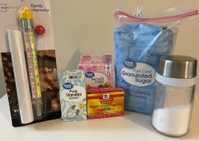
Materials required to do the experiment. It is recommended that liquid food coloring be used instead of gel coloring. Use small drops of food coloring and vanilla extract while working on the experiment. - Gather all equipment.
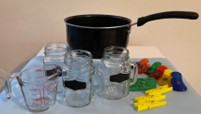
Materials required to do the experiment. Cooking pot, measuring cup, half-pint Mason jar, clothespins or cloth pegs big enough to cover the top of the opening of the Mason jar. - Before starting the candy: Dip half of each wood skewer in water, then roll each one on a plate that contains the granulated sugar. This step is very important because it will create the seed crystals that will make the rock candy. Once each wood skewer is coated with the granulated sugar, set it aside until it dries, at least two hours.
- Set the candy thermometer in the wall of the pot to check the temperature of the solution.
- Add ½ of cup of water to a cooking pot and let it boil. Let the solution reach a boiling point.
- Add 1 ½ cups of sugar a little at a time. Mix it all together at medium-high temperature.
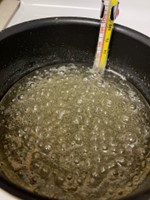
View of the sugar dissolved in water at boiling temperature. - Continue stirring the solution slowly for several minutes. Keep watching and mixing frequently to avoid crystallization of the top of the solution. It will take around 10 minutes to reach a clear liquid mixture texture.
- When the solution begins to boil, stir it rapidly until all of the sugar is mixed completely in the solution.
- Turn the heat off and add one drop of food coloring.
- Remove the pot from the burner.
- Let the solution cool for 20 minutes.
- Take the pot with the solution and pour it into the half-pint Mason jar or a tall transparent glass.
- Place the sugar-coated stick into the middle of the glass. It is very important to leave the skewer 1½ inches away from the bottom of the jar so it will not touch the bottom or the walls.
- Place a big clip into the middle of the container to hold the skewer with the sugar seed in place.
- Leave the solution there and made frequent checks. Check the crystals every hour and make sure that the skewer is not touching the bottom of the jar or the walls.
- Wait at least 3-5 days; when the crystals are done growing, use a spoon to crack the top shell of the solution.
- Gently remove the skewer with the crystals from the solution and hang it in a new container. Use a clip to hold it in place to drip the excess sugar and dry.

Final product of the at-home experiment.
Day 2
Part 3: States of Matter Particle Sticky Note Activity and Class Discussion
- Give each student three different colored sticky notes.
- Say to students: “Imagine we have a very strong microscope that can see the molecules and particles that make up each state of matter. I am going to give you 30 seconds to draw each of the following:”
- Have students label their first sticky note (Color 1) “Solid” and draw how they think the molecules behave in something solid they own (e.g., pencils, marker, paper, desk, etc.). Are the molecules moving? Are they far apart? Are they close together?
- Have students label their second sticky note (Color 2) “Liquid” and draw how they think the molecules behave in the liquid in their water bottle. Are the molecules moving? Are they far apart? Are they close together?
- Have students label their last sticky note (Color 3) “Gas” and draw how they think the molecules act in the air.
- Have the labels “Solid,” “Liquid,” and “Gas” on the white board or somewhere in the classroom.
- Have everyone take their sticky notes and place them under the label corresponding to each state of matter. Remind students that Color 1 is solids, Color 2 is liquids, and Color 3 is gases.
- Ask students to write what they notice about the drawings under each title in their science notebooks.
- Lead a class discussion of the three groupings of states of matter based on the following:
- Solid particles tend to be packed together, sometimes in tight shapes or formations.
- Liquid particles also are packed together but not as tightly as solid particles. Remind students that liquids take on the shape of their container and can flow, whereas solids are rigid and do not flow.
- Gas particles will be spread out from each other. If there is space, gas particles will expand to fill the space.
- Present the two theories of matter:
- The first theory is called Particle Theory. This theory tells us that everything is made up of very tiny bits or particles. So, matter is made up of tiny particles. When talking about particles, sometimes we use the words atom, molecule, and particle to refer to those small particles. Understanding what particles are is very helpful to later understand the behaviors of materials.
- The second theory is called Kinetic Molecular Theory. This theory states that matter is made up of particles that are constantly moving. All particles have energy, but the energy varies depending on the temperature the sample of matter is in. This, in turn, determines whether the substance exists in the solid, liquid, or gaseous state. So, we need to understand that changing the temperature of a substance could make it change from one state to another.
- Summarize what these theories mean: “Matter changes from one state to another primarily due to changes in temperature and pressure. When energy, usually in the form of heat, is added to or removed from a substance, it can cause the molecules within that substance to move more quickly or more slowly, leading to a phase change.”
- Have students practice some examples:
- How does a solid (e.g., ice) become liquid (water)? [Answer: Heating a solid (e.g., ice) can cause it to melt into a liquid (water.]
- How does a liquid (e.g., water) become a gas? [Answer: Heating a liquid (e.g., water) can cause it to evaporate into a gas (steam).]
- How does a gas become a liquid? [Answer: Cooling a gas can cause it to condense into a liquid.]
- How does a liquid become a solid? [Answer: Cooling a liquid can cause it to freeze into a solid.]
Part 4: Pop Rocks Experiment
- Ask the students if they have ever tasted a candy called Pop Rocks, (Let students raise their hands.) Tell them that today they are going to explore the states of matter using this candy, and that you will give each of them their own packet of Pop Rocks. Tell them they will use all of their senses and make predictions about the candy, recording their observations and predictions in their science notebooks.
- Have each student wash or disinfect their hands.
- Hand out one Pop Rocks candy packet to each student.
- Tell the students to open their candy bag and pour a small amount into their hand but not to eat any yet. Have them observe the candy with their eyes and ask them what state of matter they think Pop Rocks are.
- Have students write down their observations in their science notebooks. (Let students share their observations.)
- Tell the students to now taste the Pop Rocks. Ask them what sensations they feel in their mouth, and what they think is happening. (Let students offer answers: fizzy, gas, liquid, solid.)
- Have students write down their observations in their science notebooks.
- Summarize the activity: “Pop Rocks contain sugar, milk sugar (lactose), corn syrup, flavoring, and carbon dioxide gas. In our hands, they are solid (crystallized sugar candy), but in our mouths, they become liquid and gas. Why? The magic happens in the manufacturing process. Sugar syrup is heated (liquid) and then mixed with pressurized carbon dioxide gas (gas). This traps tiny bubbles of the gas inside the candy as it cools and solidifies again. In your mouth, the candy dissolves (liquid), releasing the trapped carbon dioxide (gas). The rapid release of gas creates the signature popping sound and fizzing sensation.”
- Conclude by telling students: “For ice melting at room temperature, the state change (solid to liquid) occurs due to the ongoing absorption of heat from the temperature of the room. At the same time, transition from liquid to gas (evaporation) is a separate process happening. Unlike ice melting at room temperature, Pop Rocks state changes occur (from liquid sugar syrup to solid candy) during manufacturing, not when you eat them. In your mouth, the candy dissolves (liquid) and releases the pre-trapped gas.”
Day 3
Part 5: Crazy Particles Game
- Introduce the Crazy Particles game as an introduction to Particle Theory.
- Create an open area without tables, chairs, or any objects where the game can be played.
- Clearly indicate the borders of the container or jar, or indicate the location or markers that will be the outer limits of the area that you will be using to play the game.
- Ask three students to come up with you to help you to demonstrate the rules of the game.
- Tell them that when you say “solid,” everyone begins by standing close together.
- Tell them you will give a little description of what is happening to the particles when they are solid. For example, saying, “You are frozen, you are a solid ice cube. But look, we have a surprise—the sun is coming out! You’re beginning to get a little bit warmer. And it seems that you are CHANGING TO A DIFFERENT STATE OF MATTER!. You are now behaving like a liquid. You are melting.” Everyone should continue to move around slowly.
- Then say: “You are a liquid. You are now water flowing inside a container.” Students will create groups of 2 or 3 and hold hands, moving their legs and arms but holding hands.
- Then indicate another state of matter, saying, “It is getting warmer. Some particles are changing matter because it is getting so hot, and they cannot stand it.” Students will get out of the limits and walk faster. Students inside the jar will start separating and leaving their small groups, walking a little bit faster. Students can rock back and forth with their partners until they disconnect from them.
- Then say, “It is so hot that the water is evaporating. The water is really hot—now it is boiling.” Students should move in straight lines until they hit a wall, and then they will pretend they are bouncing off and move in a straight line in a different direction.
- Tell students: “You are rising up out of the container. You are now in the air.” Students will move out of the contained area and be moving quickly all over the place. They should keep moving in straight lines until they hit a wall and then they can bounce off and move in a straight line in a different direction.
- Play music in the background while students move as if they were particles of water in the state of matter that you indicate.
Part 6: Computer Particle Simulations
- Go to the University at Colorado Boulder computer simulations web page: https://phet.colorado.edu/en/simulation/states-of-matter-basics.
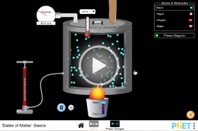
A computer simulation showing movement of molecules while applying changes on temperature on the University of Colorado Boulder Computer Simulation website. - Let students see what happens when changing temperature, or allow students to identify the state of matter by looking at different visualization models and sort them according to the three basic states.
- Have students work through the States of Matter Sorting Activity PowerPoint.
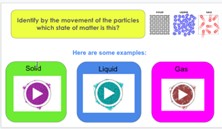
States of Matter PowerPoint Activity where students display their knowledge of the movement of particles in each state of matter. - Have students fill out the States of Matter Worksheet. (Note: Students will be able to reproduce and draw the particles’ behavior behind each state of matter.)
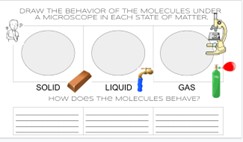
Worksheet that students will use to show their understanding of the movement of particles in each state of matter.
Part 7: Conclusion
- Have students complete the States of Matter Post-Quiz to gauge their understanding (end-of-lesson assessment).
- (optional) If the rock candy is ready, share the rock candy with the class.
Vocabulary/Definitions
change of phase: Occurs when matter changes from one state (solid, liquid, gas) to another. The temperatures and pressures under which these changes happen differ depending on the chemical and physical properties of the system. These changes occur when sufficient energy is supplied to the system, or when the pressure on the system is changed.
condensation: The action that occurs to a gas when cooled.
crystallization: A natural process that occurs as materials solidify from a liquid and create an ordered array. This can be caused by a physical change, such as a temperature change, or a chemical change, such as acidity. Crystallization consists of two major events, nucleation and crystal growth.
dissolving: Takes place when a substance is dispersed through another to become a single material. This material is called a solution.
energy: The ability to do work or make things happen. Examples include light, sound, heat, movement, and electricity.
evaporation: Occurs when a liquid is heated enough that it will boil or change state from liquid to gas.
freezing: When liquid is cooled enough, it will freeze or change state from liquid to solid.
gas: In the gas state, particles expand freely to fill the whole of the container. Atoms and molecules are far apart. Particles do not have a fixed shape (unlike a solid) and do not have a fixed volume (unlike a liquid).
liquid: The liquid state has particles that still are close together but move freely. The atoms and molecules in liquids are farther apart than in solids, which gives them the freedom to move around. Particles have a fixed volume, but they can adopt the shape of the container they are in.
nucleation: The initial process that occurs in the formation of a crystal from a solution, a liquid, or a gas, in which a small number of ions, atoms, or molecules become arranged in a pattern characteristic of a crystalline solid, forming a site upon which additional particles are deposited as the crystal grows.
physical change: A change of size, shape, or state of matter.
saturation point: The point reached when the solvent cannot dissolve any more of the solute. For example, when a water sample cannot dissolve any more sugar, the solution has reached its saturation point.
solid: The solid state has atoms and molecules huddling closely together, which makes them rigid and stiff. Molecules are frozen in place and do not flow around. Particles have a fixed shape.
solution: A liquid mixture made up of several components. The minor component (the solute) is uniformly distributed within the major component (the solvent).
state of matter: A state of matter in physics; one of the three distinct forms in which matter can exist in our world: solid, liquid, and gas. Each state has specific properties.
temperature: A physical quantity that expresses how cold or hot something is using a comparative scale.
Assessment
Pre-Activity Assessment
States of Matter Particle Sticky Note Activity and Class Discussion: Students individually draw particle behaviors for solid, liquid, and gas states of matter. After everyone shows their ideas, the class discusses the results.
Activity Embedded (Formative) Assessment
States of Matter Sorting Activity: Students see what happens when changing temperature, or allow students to identify state of matter by looking at different visualization models and sort them according to the three basic states.
Post-Activity (Summative) Assessment
Post-Quiz: Students review what they learned in the activity using the States of Matter Post-Quiz.
Optional: After the activity, ask students to watch the following video: “What are the states of matter?” After watching the video, have students gather in groups of three and engage in open discussion, writing in their science notebooks different items that belong to each state of matter.
Safety Issues
Because this activity involves working with boiling water in the kitchen, it will require close adult supervision at home. Students need to be careful and focus only on the activity when stirring the boiling solution. It is preferable that a parent or other adult stir the solution for them. The consistency of the solution (thickness and viscosity) will change from being a syrup to a liquid when the boiling solution is ready to be taken off the stove. It is required that a parent or other adult be present to help and supervise students and make sure that the area of preparation is clear from obstacles and safe. This is a fun homework assignment, but it requires concentration, and no toddlers or other small children should be playing nearby. It is preferable to do the activity after carefully reviewing the sequence and steps of the procedure. Keep the handout with the steps nearby during the entire procedure.
- Use caution near the flame from the stove.
- Use careful movements when you mix the liquid in your pot and you are near the hot stove.
- Use thermal gloves and avoid touching the pot or any surface exposed to heat.
- Use eye protection (goggles or safety glasses) during this activity.
- Wash your hands, disinfect the zone that you will be using, and clean all of the containers that you will use before mixing your ingredients. Although the bacteria that occur naturally during the experiment are generally harmless, students should nevertheless wash their hands after finishing the experiment.
Troubleshooting Tips
Students doing the experiment at home need to prepare the sugar-coated wood skewers in advance. Let the mixture cool for at least 30 minutes; if it's too hot, the sugar coating on the skewer will dissolve, ruining the crystal seed needed for the candy to form. The crystal seed helps attract sugar molecules to the skewer.
If the solution is left to cool for too long (several days), sugar crystals will form throughout the entire pot or jar.
Ensure that the skewer is not touching the jar’s bottom or sides, and keep it at least 1 ½ inches
Activity Extensions
Crazy Particle Game: Here’s how to explain and teach the Crazy Particles Game, which introduces students to Particle Theory and the three states of matter. You'll need a gym or open space without obstacles, and some music for the background.
Setup:
- Prepare the Space: Define the boundaries of the play area, which will represent the "container" where particles (students) move. You can mark the area with cones or tape to set the outer limits.
- Explain the States of Matter: Start by telling the students that they will act like water particles in different states of matter—solid, liquid, and gas.
Instructions:
- Solid State:
- Teacher's Direction: Tell students they are now in a solid state (like ice).
- Movement: Students should group together tightly, standing close without moving much. Explain that in solids, particles are packed closely and only vibrate in place.
- Teacher's Narration: Say something like, “You are frozen ice particles! You can only vibrate a little bit in place.”
- Transition to Liquid:
- Teacher's Direction: Say, “The sun is coming out, and you are getting warmer! You’re melting into water, a liquid.”
- Movement: Students move around slowly, holding hands in groups of 2-3, representing how particles in a liquid move but still staying relatively close.
- Teacher's Narration: Explain that liquid particles can move past one another but remain together within a container. “You are flowing water now, still staying within the boundaries of the container.”
- Transition to Gas:
- Teacher's Direction: Say, “It’s getting hotter, and the water is starting to evaporate into gas!”
- Movement: Students let go of their partners and move quickly in straight lines, bouncing off the walls or boundaries as they "evaporate." Emphasize that gas particles move freely and spread out.
- Teacher's Narration: Describe how gas particles are far apart and move randomly. “You are now water vapor rising into the air. You are moving freely, no longer confined to a container.”
- Phase Changes:
- As the game progresses, you can switch between states of matter by calling out “solid,” “liquid,” or “gas,” and have students change their movements accordingly.
- Optionally, introduce cooling so they can reverse the process, going from gas to liquid, and back to solid by "freezing" again.
Summary:
After the game, discuss how their movements reflected the behavior of particles in different states of matter. Explain that in solids, particles are tightly packed and vibrate; in liquids, they move around each other but stay close; and in gases, they spread out and move freely.
This activity is a fun, physical way to help students understand the dynamic nature of particles in different states of matter!
Activity Scaling
For lower grades, play the Crazy Particle Game (Introduction to Particle Theory) only.
Additional Multimedia Support
States of Matter for Kids |Solids, Liquids, and Gases Video (Learn Bright)
PBS Learning Media - States of Matter
Subscribe
Get the inside scoop on all things TeachEngineering such as new site features, curriculum updates, video releases, and more by signing up for our newsletter!More Curriculum Like This

Students are introduced to chemical engineering and learn about its many different applications. An associated hands-on activity gives students a chance to test their knowledge of the states of matter and how to make observations using their five senses: touch, smell, sound, sight and taste.

tudents are introduced to the similarities and differences in the behaviors of elastic solids and viscous fluids. In addition, fluid material properties such as viscosity are introduced, along with the methods that engineers use to determine those physical properties.

Students learn how to classify materials as mixtures, elements or compounds and identify the properties of each type. The concept of separation of mixtures is also introduced since nearly every element or compound is found naturally in an impure state such as a mixture of two or more substances, and...

To gain an understanding of mixtures and the concept of separation of mixtures, students use strong magnets to find the element of iron in iron-fortified breakfast cereal flakes. Through this activity, they see how the iron component of this heterogeneous mixture (cereal) retains its properties and ...
References
05/22/2022. https://klru.pbslearningmedia.org/
05/22/2022. https://phet.colorado.edu/en/simulation/states-of-matter-basics
Other Related Information
What causes matter to change from one state to another?
Answer: Matter changes from one state to another primarily due to changes in temperature and pressure. When energy, usually in the form of heat, is added to or removed from a substance, it can cause the molecules within that substance to move more quickly or slowly, leading to a phase change. For example:
- Heating a solid (e.g., ice) can cause it to melt into a liquid (e.g., water).
- Heating a liquid (e.g., water) can cause it to evaporate into a gas (e.g., steam).
- Cooling a gas can cause it to condense into a liquid.
- Cooling a liquid can cause it to freeze into a solid.
- Increasing pressure on a gas can force it into a liquid state (and vice versa).
What do we look for to identify the state of matter?
Answer: To identify the state of matter, we look at several physical properties:
- Shape and volume: Solids have a fixed shape and volume. Liquids have a fixed volume but take the shape of their container. Gases have neither a fixed shape nor a fixed volume, expanding to fill their container.
- Particle arrangement: In solids, particles are tightly packed in a regular pattern. In liquids, particles are close but not in a fixed position, allowing them to flow. In gases, particles are far apart and move freely.
- Energy levels: The energy of particles is highest in gases, lower in liquids, and lowest in solids.
How can we tell if a substance is a solid, liquid, or gas?
Answer: We can determine whether a substance is a solid, liquid, or gas by observing its characteristics and behavior:
- Solids have a definite shape and volume. Solids are rigid and do not flow. Examples include ice, wood, and metal.
- Liquids have a definite volume but no definite shape. Liquids take the shape of their container and can flow. Examples include water, oil, and mercury.
- Gases have neither a definite shape nor a definite volume. Gases expand to fill their container and can be compressed. Examples include air, steam, and helium.
Copyright
© 2024 by Regents of the University of Colorado; original © 2021 University of Texas at AustinContributors
Patricia González-Villaseñor, Zach Sherman, Becky Mozilo, and Thomas TruskettSupporting Program
CDCM MRSEC RET Program, University of Texas at AustinAcknowledgements
This curriculum was developed under the National Science Foundation MRSEC RET program. Any opinions, findings, and conclusions of recommendations expressed in this material are those of the authors, and do not necessarily reflect the views of the National Science Foundation.
Last modified: September 27, 2024









User Comments & Tips